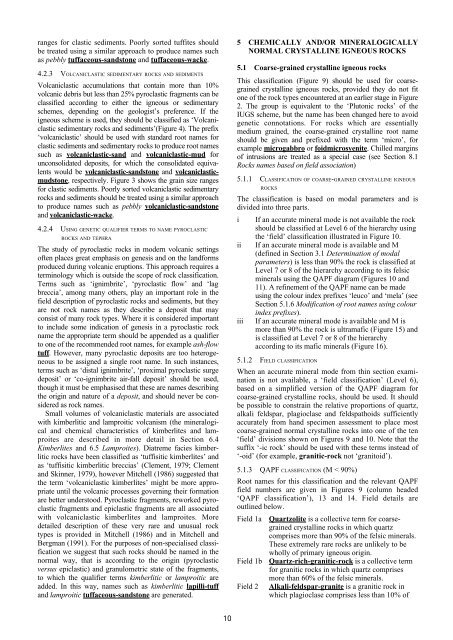Rock Classification Scheme (BGS).pdf - The Water, Sanitation and ...
Rock Classification Scheme (BGS).pdf - The Water, Sanitation and ...
Rock Classification Scheme (BGS).pdf - The Water, Sanitation and ...
Create successful ePaper yourself
Turn your PDF publications into a flip-book with our unique Google optimized e-Paper software.
anges for clastic sediments. Poorly sorted tuffites shouldbe treated using a similar approach to produce names suchas pebbly tuffaceous-s<strong>and</strong>stone <strong>and</strong> tuffaceous-wacke.4.2.3 VOLCANICLASTIC SEDIMENTARY ROCKS AND SEDIMENTSVolcaniclastic accumulations that contain more than 10%volcanic debris but less than 25% pyroclastic fragments can beclassified according to either the igneous or sedimentaryschemes, depending on the geologist’s preference. If theigneous scheme is used, they should be classified as ‘Volcaniclasticsedimentary rocks <strong>and</strong> sediments’(Figure 4). <strong>The</strong> prefix‘volcaniclastic’ should be used with st<strong>and</strong>ard root names forclastic sediments <strong>and</strong> sedimentary rocks to produce root namessuch as volcaniclastic-s<strong>and</strong> <strong>and</strong> volcaniclastic-mud forunconsolidated deposits, for which the consolidated equivalentswould be volcaniclastic-s<strong>and</strong>stone <strong>and</strong> volcaniclasticmudstone,respectively. Figure 3 shows the grain size rangesfor clastic sediments. Poorly sorted volcaniclastic sedimentaryrocks <strong>and</strong> sediments should be treated using a similar approachto produce names such as pebbly volcaniclastic-s<strong>and</strong>stone<strong>and</strong> volcaniclastic-wacke.4.2.4 USING GENETIC QUALIFIER TERMS TO NAME PYROCLASTICROCKS AND TEPHRA<strong>The</strong> study of pyroclastic rocks in modern volcanic settingsoften places great emphasis on genesis <strong>and</strong> on the l<strong>and</strong>formsproduced during volcanic eruptions. This approach requires aterminology which is outside the scope of rock classification.Terms such as ‘ignimbrite’, ‘pyroclastic flow’ <strong>and</strong> ‘lagbreccia’, among many others, play an important role in thefield description of pyroclastic rocks <strong>and</strong> sediments, but theyare not rock names as they describe a deposit that mayconsist of many rock types. Where it is considered importantto include some indication of genesis in a pyroclastic rockname the appropriate term should be appended as a qualifierto one of the recommended root names, for example ash-flowtuff. However, many pyroclastic deposits are too heterogeneousto be assigned a single root name. In such instances,terms such as ‘distal ignimbrite’, ‘proximal pyroclastic surgedeposit’ or ‘co-ignimbrite air-fall deposit’ should be used,though it must be emphasised that these are names describingthe origin <strong>and</strong> nature of a deposit, <strong>and</strong> should never be consideredas rock names.Small volumes of volcaniclastic materials are associatedwith kimberlitic <strong>and</strong> lamproitic volcanism (the mineralogical<strong>and</strong> chemical characteristics of kimberlites <strong>and</strong> lamproitesare described in more detail in Section 6.4Kimberlites <strong>and</strong> 6.5 Lamproites). Diatreme facies kimberliticrocks have been classified as ‘tuffisitic kimberlites’ <strong>and</strong>as ‘tuffisitic kimberlitic breccias’ (Clement, 1979; Clement<strong>and</strong> Skinner, 1979), however Mitchell (1986) suggested thatthe term ‘volcaniclastic kimberlites’ might be more appropriateuntil the volcanic processes governing their formationare better understood. Pyroclastic fragments, reworked pyroclasticfragments <strong>and</strong> epiclastic fragments are all associatedwith volcaniclastic kimberlites <strong>and</strong> lamproites. Moredetailed description of these very rare <strong>and</strong> unusual rocktypes is provided in Mitchell (1986) <strong>and</strong> in Mitchell <strong>and</strong>Bergman (1991). For the purposes of non-specialised classificationwe suggest that such rocks should be named in thenormal way, that is according to the origin (pyroclasticversus epiclastic) <strong>and</strong> granulometric state of the fragments,to which the qualifier terms kimberlitic or lamproitic areadded. In this way, names such as kimberlitic lapilli-tuff<strong>and</strong> lamproitic tuffaceous-s<strong>and</strong>stone are generated.5 CHEMICALLY AND/OR MINERALOGICALLYNORMAL CRYSTALLINE IGNEOUS ROCKS5.1 Coarse-grained crystalline igneous rocksThis classification (Figure 9) should be used for coarsegrainedcrystalline igneous rocks, provided they do not fitone of the rock types encountered at an earlier stage in Figure2. <strong>The</strong> group is equivalent to the ‘Plutonic rocks’ of theIUGS scheme, but the name has been changed here to avoidgenetic connotations. For rocks which are essentiallymedium grained, the coarse-grained crystalline root nameshould be given <strong>and</strong> prefixed with the term ‘micro’, forexample microgabbro or foidmicrosyenite. Chilled marginsof intrusions are treated as a special case (see Section 8.1<strong>Rock</strong>s names based on field association)5.1.1 CLASSIFICATION OF COARSE-GRAINED CRYSTALLINE IGNEOUSROCKS<strong>The</strong> classification is based on modal parameters <strong>and</strong> isdivided into three parts.i If an accurate mineral mode is not available the rockshould be classified at Level 6 of the hierarchy usingthe ‘field’ classification illustrated in Figure 10.ii If an accurate mineral mode is available <strong>and</strong> M(defined in Section 3.1 Determination of modalparameters) is less than 90% the rock is classified atLevel 7 or 8 of the hierarchy according to its felsicminerals using the QAPF diagram (Figures 10 <strong>and</strong>11). A refinement of the QAPF name can be madeusing the colour index prefixes ‘leuco’ <strong>and</strong> ‘mela’ (seeSection 5.1.6 Modification of root names using colourindex prefixes).iii If an accurate mineral mode is available <strong>and</strong> M ismore than 90% the rock is ultramafic (Figure 15) <strong>and</strong>is classified at Level 7 or 8 of the hierarchyaccording to its mafic minerals (Figure 16).5.1.2 FIELD CLASSIFICATIONWhen an accurate mineral mode from thin section examinationis not available, a ‘field classification’ (Level 6),based on a simplified version of the QAPF diagram forcoarse-grained crystalline rocks, should be used. It shouldbe possible to constrain the relative proportions of quartz,alkali feldspar, plagioclase <strong>and</strong> feldspathoids sufficientlyaccurately from h<strong>and</strong> specimen assessment to place mostcoarse-grained normal crystalline rocks into one of the ten‘field’ divisions shown on Figures 9 <strong>and</strong> 10. Note that thesuffix ‘-ic rock’ should be used with these terms instead of‘-oid’ (for example, granitic-rock not ‘granitoid’).5.1.3 QAPF CLASSIFICATION (M < 90%)Root names for this classification <strong>and</strong> the relevant QAPFfield numbers are given in Figures 9 (column headed‘QAPF classification’), 13 <strong>and</strong> 14. Field details areoutlined below.Field 1aField 1bField 2Quartzolite is a collective term for coarsegrainedcrystalline rocks in which quartzcomprises more than 90% of the felsic minerals.<strong>The</strong>se extremely rare rocks are unlikely to bewholly of primary igneous origin.Quartz-rich-granitic-rock is a collective termfor granitic rocks in which quartz comprisesmore than 60% of the felsic minerals.Alkali-feldspar-granite is a granitic rock inwhich plagioclase comprises less than 10% of10
















